#southern white rhinos
Explore tagged Tumblr posts
Text

These southern white rhinos are part of a 2,000-strong group that were put up for auction by a private captive rhino breeding operation in South Africa. A non-profit NGO, African Parks, has taken custody of the herd and plans to rewild the animals across the continent over a 10-year period, as well as turning the original farm into a rhino sanctuary
Photograph: Siphiwe Sibeko/Reuters
#siphiwe sibeko#photographer#reuters#southern white rhinos#rhinoceros#animal#mammal#wildlife#south africa#african parks#nature
10 notes
·
View notes
Text
I now see the second article is specific to northern white rhinos, while the first article must be about southern white rhinos only.
365 notes
·
View notes
Text




The news has gifted us with the most cursed subtitle fuck up.
#shitpost#context#this is about a rhino named zanta#Dublin zoo#rhinos#southern white rhinoceros#Santa#we stan transanta#mpreg Santa#cursed#current events
105 notes
·
View notes
Text

Southern white rhinoceros Ceratotherium simum simum
Observed by faerout, CC BY-NC
30 notes
·
View notes
Text
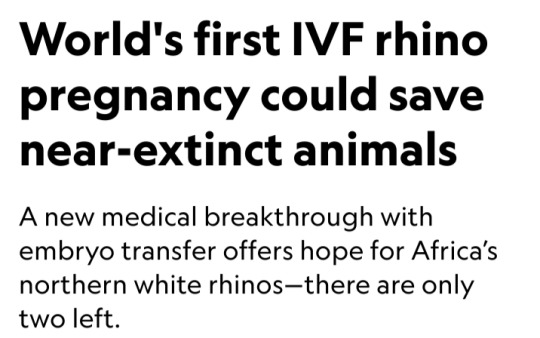
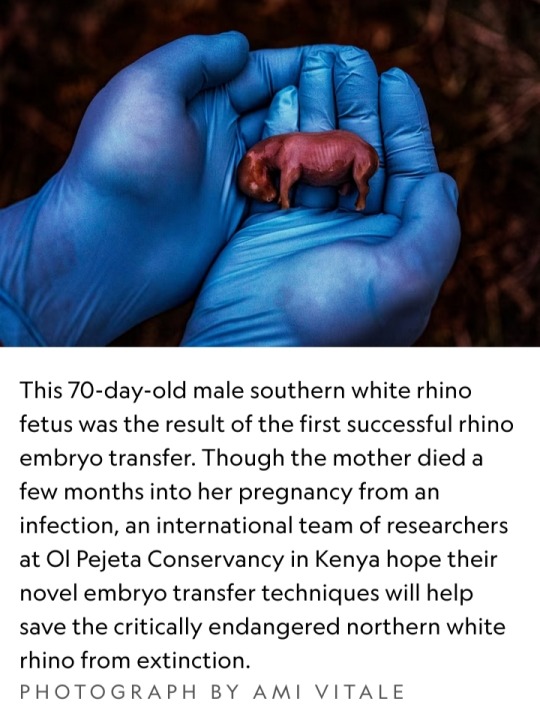
By Dina Fine Maron
January 24, 2024
Scientists have cleared a significant hurdle in the years-long effort to save Africa’s northern white rhinoceros from extinction with the first-ever rhino pregnancy using in vitro fertilization.
The lab-assisted pregnancy, which researchers will announce today, involved implanting a southern white rhino embryo in a surrogate mother named Curra.
The advance provides the essential “proof of concept” that this strategy could help other rhinos, says Jan Stejskal of the BioRescue project, the international group of scientists leading this research.
Curra died just a couple months into her 16-month pregnancy from an unrelated bacterial infection, Stejskal says.
However, the successful embryo transfer and early stages of pregnancy pave the way for next applying the technique to the critically endangered northern white rhino.
The process was documented exclusively by National Geographic for an upcoming Explorer special currently slated to air in 2025 on Nat Geo and Disney+.
BioRescue expects to soon implant a northern white rhino embryo into a southern white rhino surrogate mother.
The two subspecies are similar enough, according to the researchers, that the embryo will be likely to develop.
Eventually, this approach may also help other critically endangered rhinos, including the Asian Javan rhinoceros and the Sumatran rhinoceros, which each now number under 100 individuals, Stejskal says.
But the northern white rhino’s current situation is the most pressing by far.
There are no males left, and the only two remaining animals are both elderly females that live under armed guard on a reserve in a 700-acre enclosure in Kenya called Ol Pejeta Conservancy.
The boxy-jawed animals once roamed across central Africa, but in recent decades, their numbers have plummeted due to the overwhelming international demand for their horn, a substance used for unproved medicinal applications and carvings.
Made from the same substance as fingernails, rhino horn is in demand from all species, yet the northern white rhino has been particularly hard-hit.
"These rhinos look prehistoric, and they had survived for millions of years, but they couldn’t survive us,” says Ami Vitale, a National Geographic Explorer and photographer who has been documenting scientists’ efforts to help the animals since 2009.
“If there is some hope of recovery within the northern white rhino gene pool — even though it’s a substantially smaller sample of what there was — we haven’t lost them,” says conservation ecologist David Balfour, who chairs the International Union for the Conservation of Nature’s African rhino specialist group.
Blueprints for rhino babies

To stave off the animal’s disappearance, BioRescue has used preserved sperm from northern white rhinos and eggs removed from the younger of the two remaining females.
So far, they’ve created about 30 preserved embryos, says Thomas Hildebrandt, the head scientist of BioRescue and an expert in wildlife reproduction based at the Leibniz-Institute of Zoo and Wildlife Research in Berlin.
Eventually, the team plans to reintroduce northern white rhinos into the wild within their range countries.
“That’d be fantastic, but really, really far from now—decades from now,” says Stejskal.
Worldwide, there are five species of rhinoceros, and many are in trouble.
Across all of Africa, there are now only about 23,000 of the animals, and almost 17,000 of them are southern whites.
Then there are more than 6,000 black rhinos, which are slightly smaller animals whose three subspecies are critically endangered.
In Asia, beyond the critically endangered Javan and Sumatran rhinos, there’s also the greater one-horned rhino, whose numbers are increasing and currently are estimated to be around 2,000.
The BioRescue effort has experienced many setbacks, and even though the team now has frozen embryos, the clock is ticking.
The researchers intend to use southern white rhinos as surrogate moms for the northern white rhino embryos.
However, scientists want any northern white rhino calves to meet and learn from others of their kind, which means they need to be born before the two remaining females die.
“These animals learn behaviors — they don’t have them genetically hard-wired,” says Balfour, who’s not involved with the BioRescue work.
But birthing new animals in time will be a challenge.
“We’re really skating on the edge of what’s possible,” he says, “but it’s worth trying.”
Najin, the older female, will be 35 this year, and Fatu will be 24.
The animals, which were born in a zoo in the Czech Republic, are expected to live to about 40, says Stejskal, who also serves as director of international projects at the Safari Park Dvůr Králové, the zoo where the animals lived until they were brought to Kenya in 2009.
Impregnating a rhino

The next phase of BioRescue’s plan involves implanting one of their limited number of northern white rhino embryos into a southern white rhino surrogate mother — which the group plans to do within the next six months, Stejskal says.
They’ve identified the next surrogate mother and set up precautions to protect her from bacterial infections, including a new enclosure and protocols about disinfecting workers’ boots.
But now, they must wait until the female rhino is in estrus — the period when the animal is ready to mate — to implant the egg.
To identify that prime fertile time, they can’t readily perform regular ultrasounds at the conservancy as they might do in a zoo.
Instead, they have enlisted a rhino bull that has been sterilized to act as a “teaser” for the female, Hildebrandt says, adding that they must wait a few months to make sure that their recently sterilized male is truly free of residual sperm.
Once the animals are brought together, their couplings will alert conservancy staff that the timing is right for reproductive success.
The sex act is also important because it sets off an essential chain of events in the female’s body that boosts the chances of success when they surgically implant the embryo about a week later.
"There’s little chance the conservancy staff will miss the act. White rhinos typically mate for 90 minutes," Hildebrandt says.
What’s more, while mounted on the females, the males often use their temporary height to reach tasty plant snacks that are generally out of reach.
Boosting genetic diversity
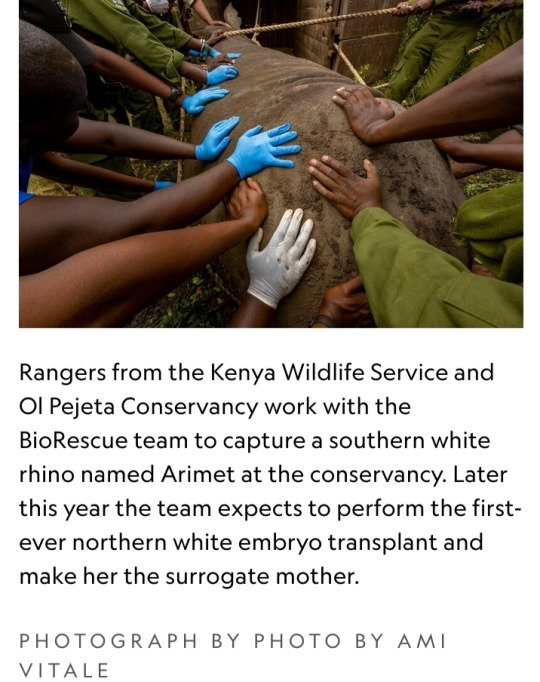
With so few northern white rhinos left, their genetic viability may seem uncertain.
But the BioRescue team points to southern white rhinos, whose numbers likely dropped to less than 100, and perhaps even as few as 20, due to hunting in the late 1800s.
Government protections and intense conservation strategies allowed them to bounce back, and now there are almost 17,000.
“They have sufficient diversity to cope with a wide range of conditions,” says Balfour.
Researchers don’t know exactly how many southern white rhinos existed a century ago, he says, but it’s clear that the animals came back from an incredibly low population count and that they now appear healthy.
Beyond their small collection of embryos, the BioRescue team hopes to expand the northern white rhino’s gene pool by drawing from an unconventional source — skin cells extracted from preserved tissue samples that are currently stored at zoos.
They aim to use stem cell techniques to reengineer those cells and develop them into sex cells, building off similar work in lab mice.
According to their plan, those lab-engineered sex cells would then be combined with natural sperm and eggs to make embryos, and from there, the embryos would be implanted into southern white rhino surrogate mothers.
Such stem cell reprogramming work has previously led to healthy offspring in lab mice, Hildebrandt says, but rhinos aren’t as well-studied and understood as mice, making this work significantly challenging.
A global effort
The northern white rhino revitalization venture has cost millions of dollars, supported by a range of public and private donors, including the German Federal Ministry of Education and Research.
Other partners on the effort include the Leibniz Institute for Zoo and Wildlife Research, the Czech Republic’s Safari Park, Kenya Wildlife Service, Ol Pejeta Conservancy, and also Katsuhiko Hayashi, a professor of genome biology at Osaka University in Japan who conducted the mouse stem cell research.
Building upon Hayashi’s stem cell techniques could ultimately bring the northern white rhino gene pool up to 12 animals — including eggs from eight females and the semen of four bulls, according to Stejskal.
An alternative approach to making more babies, like crossbreeding northern and southern white rhinos, would mean the resulting calves wouldn’t be genetically pure northern white rhinos, Hildebrandt notes.
The two subspecies look quite similar, but the northern version has subtle physical differences, including hairier ears and feet that are better suited to its swampy habitat.
The two animals also have different genes that may provide disease resiliency or other benefits, Hildebrandt says.
There are unknown potential differences in behavior and ecological impact when populating the area with southern white rhinos or cross-bred animals.
"The northern white rhino is on the brink of extinction really only due to human greed,” Stejskal says.
“We are in a situation where saving them is at our fingertips, so I think we have a responsibility to try.”

🩶🦏🩶
#northern white rhinoceros#rhino embryo transfer#in vitro fertilization#IVF#southern white rhinoceros#critically endangered animals#National Geographic#BioRescue#rhino horn#International Union for the Conservation of Nature#African rhino specialist group#Thomas Hildebrandt#German Federal Ministry of Education and Research#Leibniz Institute for Zoo and Wildlife Research#Kenya Wildlife Service#Ol Pejeta Conservancy#Katsuhiko Hayashi#genome biology#IVF rhino pregnancy
10 notes
·
View notes
Text













World Rhino Day
Visit a wildlife preservation, “adopt” a rhino, or donate to any of the many organizations caring for this fascinating but tragically endangered species.
Almost every child in the world should be able to immediately recognize this magnificent beast, with its heavy grey skin and prominent horn (or horns!) upon its snout. The rhinoceros is a much-loved critter!
However, it is deeply endangered in the wild and is quickly on the road to extinction if something isn’t done to help this animal in its plight. So it is that World Rhino Day was established to help raise awareness and protect what remains of these magnificent creatures.
History of World Rhino Day
As far back as the early 1990s, the crisis related to rhinos in Africa, particularly the black rhinos in Zimbabwe, became well known and people began to be concerned. By 2010, it was apparent that the potentially hazardous future of the Rhinoceros still wasn’t well known to various people around the world. At that time, most people did not know just how close the planet was coming to the total extinction of this majestic species.
So critical and dire was the condition of the species that less than 30,000 rhinos were alive in the world at that time. It was because of this that the WWF-South Africa announced World Rhino Day with the desire to save the world’s remaining rhinos, an effort that grew to be an unprecedented success.
In 2011, a woman named Lisa Jane Campbell fired off an email to Rhishja, a fellow lover of rhinos who wanted to see the five species of rhinos in the world continue to thrive and be there for future generations to enjoy.
At the hands of these two incredible women, World Rhino Day has become a phenomenon that spreads across the globe and has been a resounding success.
There’s still work to do though, as there are only about 100 Sumatran Rhinos left in the world, and between 60-65 Javan rhinos. So, while the rhino populations of Africa are doing well, there are certainly still more to save.
Taking the time out on Rhino Day to be aware and share the concern about the struggle this species faces is a great way to celebrate the day!
How to Celebrate World Rhino Day
Celebrating World Rhino Day starts by people deciding to educate themselves on the plight of rhinoceros in the modern world. In this way, people can figure out what actions they can take to help save those that remain. Try these ideas for celebrating this important day:
Learn More About Rhino-Friendly Organizations
Take a look at these reputable organizations that are doing what they can to help remove the burden from the lives of rhinos:
World Wildlife Federation (WWF). For almost 50 years, WWF has been working on behalf of rhinos by aiming to expand protected areas where rhinos can live and breed safely, improving security to prevent poaching, helping with law enforcement to keep the trading of wildlife illegal, and promoting wildlife based tourism that expands experiences and funds more efforts toward conservation.
Save the Rhino International. Beginning in 1992, Save the Rhino uses extreme challenges to raise money in the UK and beyond to help fund efforts for rhinos. Working to protect rhinos from poaching, educating communities who live near rhinos, and bringing experts together to share information and skills allows this organization to be effective in their goal of saving the rhinos.
International Rhino Foundation. Fighting for the survival of rhinos, this organization offers support through grants and field programs that have affected rhino conservation in at least ten countries. Focusing on protecting, education, breeding, conservation and demand reduction, this group was also founded in the early 1990’s.
Adopt a Rhino Orphan
In addition to the organizations listed above, Helping Rhinos is a group that pairs people with baby rhinos whose parents are not able to take care of them. Adoption participation is a minimal cost per month or year, and those who want to adopt can choose which baby rhino they want to help support.
Adoption comes with a certificate with the name, photo, and fact sheet of the adopted rhino as well as a subscription to e-news from the Helping Rhinos Organization. Check out the website to see stories of which rhinos are available for adoption and how they came to be rescued and placed in the rhino orphanages for care.
Share with Family and Friends about Rhinos
Rhinos are such an impressive symbol of strength, resilience, and tenacity that it would be a heartbreaking shame to have those traits disappear as they become a species that used to exist. Don’t let these magnificent creatures disappear from the world, get together with friends and family and see what you can do to help build funds to protect them.
Throw a little party or get-together in honor of Rhino Day where guests can be educated on the worries about the future for Rhinos. Be ready to share fun facts about the uniqueness of rhinos, how important they are to their habitat areas, and what makes them such an interesting species. Help guests understand what they can do to help promote the cause, and perhaps take some donations to send to organizations, or encourage guests to consider adopting one of the orphan rhinos.
Source
#Lewa Savanne#zebra#Zoo Zürich#Zurich#day trip#spring 2023#original photography#tourist attraction#landmark#outdoors#indoors#Schweiz#Switzerland#animal#World Rhino Day#22 September#WorldRhinoDay#rhinoceros#quus grevyi#Grévy's zebra#Südliches Breitmaulnashorn#Ceratotherium simum simum#Southern white rhinoceros#fauna#flora#nature
2 notes
·
View notes
Text
Y'ALL THEY'VE LEARNED TO IVF RHINO'S AND I AM LIVING
#rhino#northern white rhino#southern white rhino#i so deeply want to yell but i am on a train#like this shit isnt perfect but theres steps being taken and we may just buy ourselves time to get there
5 notes
·
View notes
Photo










Born to be wild! 🐻🐎
Kilimanjaro Safaris 🐯🐘🐼🐒🐦 Disney’s Animal Kingdom
#And someday we'll look back and say it was fun#disney#kilimanjaro safaris#walt disney#rhino#southern white rhino#walt disney world#crocodile#nile crocodile#disney world#saddle-billed stork#disney animal kingdom#black rhino#wildlife#safari#walt disney world resort#florida
4 notes
·
View notes
Text
on endlings, and despair
Hey, y'all. It's...been a rough couple of weeks. So, I thought--better to light a single candle, right?
If you're familiar with wildlife conservation success stories, then you're likely also familiar with their exact polar opposite. The Northern White Rhino. Conservation's poster child for despair. Our greatest and most high-profile utter failure. We slaughtered them for wealth and status, and applied the brakes too slow. Changed course too late.
We poured everything we had into trying to save them, and we failed.
We lost them. They died. The last surviving male was named Sudan. He died in 2018, elderly and sick. His genetic material is preserved, along with frozen semen from other long-dead males, but only as an exercise in futility. Only two females survive--a mother and daughter, Najin and Fatu.
Both of them are infertile. They still live; but the Northern White Rhinoceros is extinct. Gone forever.
In 2023, an experimental procedure was attempted, a hail-mary desperation play to extract healthy eggs from the surviving females.
It worked.
The extracted eggs were flown to a genetics lab, and artificially fertilized using the sperm of lost Northern males. The frozen semen that we kept, all this time, even after we knew that the only living females were incapable of becoming pregnant.
It worked.
Thirty northern white rhino embryos were created and cryogenically preserved, but with no ability to do anything with them, it was a thin hope at best. In 2024, for the first time, an extremely experimental IVF treatment was attempted on a SOUTHERN white rhino--a related subspecies.
It worked.
The embryo transplanted as part of the experiment had no northern blood--but the pregnancy took. The surgery was safe for the mother. The fetus was healthy. The procedure is viable. Surrogate Southern candidates have already been identified to carry the Northern embryos. Rhinoceros pregnancies are sixteen months long, and the implantation hasn't happened yet. It will take time, before we know. Despair is fast and loud. Hope is slower, softer. Stronger, in the end.
The first round may not take. We'll learn from it. It's what we do. We'll try again. Do better, the next time. Fail again, maybe. Learn more. Try harder.
This will not save the species. Not overnight. The numbers will be very low, with no genetic diversity to speak of. It's a holding action, nothing more.
Nothing less.
One generation won't save a species. But even a single calf will buy us time. Not quite gone, not yet. One more generation. One more endling. One more chance. And if we seize it, we might just get another after that. We're getting damn good at gene editing. At stem-cell research. In the length of a single rhino lifetime, we'll get even better.
For decades, we have been in a holding action with no hope in sight. Researchers, geneticists, environmentalists, wildlife rehabbers. Dedicated and heroic Kenyan rangers have kept the last surviving NWRs under 24/7 armed guard, line-of-sight, eyes-on, never resting, never relaxing their guard. Knowing, all the while, that their vigilance was for nothing. Would save nothing. This is a dead species--an elderly male, two females so closely related that their offspring couldn't interbreed even if they could produce any--and they can't.
Northern white rhino conservation was the most devastatingly hopeless cause in the world.
Two years from now, that dead species may welcome a whole new generation.
It's a holding action, just a holding action, but not "just". There is a monument, at the Ol Pejeta Conservancy, where the last white rhinos have lived and will die. It was created at the point where we knew--not believed, knew--that the species was past all hope. It memorializes, by name there were so few, the last of the northern white rhinos. Most of the markers have brief descriptions--where the endling rhino lived, how it was rescued, how it died.
One marker bears only these words: SUDAN | Last male Northern White Rhino.
If even a single surrogate someday bears a son, we have erased the writing on that plaque forever.
All we can manage is a holding action? Then we hold. We hold hard and fast and long, use our fingernails if we have to. But hold. Even and perhaps especially when we are past all hope.
We never know what miracle we might be buying time for.
19K notes
·
View notes
Text







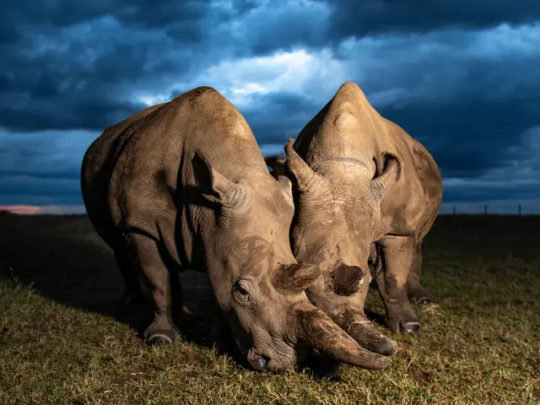




Ceratotherium simum, better known as the white rhinoceros, white rhino or square-lipped rhinoceros, is a species of rhinoceros native to sub Saharan Africa. The white rhinoceros consists of two subspecies: the southern white rhinoceros, with an estimated 18,000 wild-living animals, and the much rarer northern white rhinoceros with only two confirmed living individuals both being captive females: Fatu and Najin. Sudan, the world's last known male northern white rhinoceros, died in Kenya on 19 March 2018 at age 45. Today White Rhinos can be found throughout South Africa, Namibia, Mozambique, Zimbabwe, Zambia, Kenya, and Uganda where they inhabit long and short-grass savannahs feeding upon grasses, sedges, forbs, flowers, and some leaves. White rhinos are themselves occasionally preyed upon by lions, hyenas, and crocodiles. The white rhino is the most social of all extant rhinos and live in crashes or herds of up to 14 animals. They are also deceptively fast animals capable of reach upwards of 30 mph (48kph) in a sprint. With males reaching around 12 to 13ft (3.7 to 4m) in length, 5.6 to 6.1ft (1.7-1.9 meters) tall at the shoulder, and 4,410–5,070lbs (2,000–2,300 kgs) in weight and females reaching 11 to 12ft (3.35–3.65m) long, 5.25–5.8ft (1.6-1.8m) tall, and 3,530–3,750lbs (1,600–1,700 kgs) in weight, the white rhino is the largest species of rhino and the 4th largest land animal after the 3 species of elephant. They are large, broad animals with thick, grey skin. The white rhinoceros has two horns, with the front horn being much longer than the secondary horn. The head of the rhinoceros is almost rectangular in shape with a square snout. Breeding may occur year round with mates staying together for at least 5–20 days. After a 16 month pregnancy a mother white rhino will give birth to a single calf which will remain by there mothers side for two to three years. Under ideal conditions a white rhino will reach sexual maturity at 6 to 7 years for females and 10 to 12 years for males, and may live upwards of 50 years.
#pleistocene pride#pliestocene pride#pleistocene#cenozoic#white rhino#rhino#rhinoceros#animal facts#northern white rhino#southern white rhino#wildlife#extinct#recently extinct
1 note
·
View note
Text
The Kenya Wildlife Service celebrated the successful transfer of 21 eastern black rhinos to establish a new viable breeding population for the species that was on the brink of extinction decades ago.
In an 18-day exercise executed by highly trained capture and veterinary experts, the Loisaba Conservancy received the 21 rhinos from three different locations, becoming the 17th sanctuary in Kenya where the mammoth animals can roam and intermingle.
“It’s incredibly exciting to be part of the resettlement of rhinos to a landscape where they’ve been absent for 50 years,” said Tom Silvester, CEO of Loisaba Conservancy.
Kenya had 20,000 black rhinos in the 1970s before poachers decimated them for their horns. By the time the Kenya Wildlife Service (KWS) was established in 1989, rhino numbers had declined to below 400.
Since then, Kenya’s eastern black rhinos have made a remarkable comeback and today there are an estimated 1,004 individuals.
Kenya is a stronghold of the eastern sub species of black rhino, hosting approximately 80 percent of the entire world’s surviving population.
“Surpassing the milestone of 1,000 rhinos within four decades is a significant accomplishment,” said Munira Bashir, Director of The Nature Conservancy in Kenya.
The reintroduction this month of these 21 animals this month is a great milestone in Kenya’s rhino recovery action plan, and was made possible by support from The Nature Conservancy, San Diego Zoo Wildlife Alliance, other partners—and the three reserves from where the 21 rhinos originated, Nairobi National Park, Ol Pejeta Conservancy and Lewa Conservancy.
“In the recent past, one of the main causes of mortality of rhinos has been territorial fights due to limited space in sanctuaries which has also led to suppressed growth rates due,” explained Dr. Erustus Kanga, the Director General of Kenya Wildlife Service. “I am elated to be associated with this momentous effort to secure more space for this cornerstone species.”
Meanwhile, southern white rhinos continue to thrive in Kenya, having increased from 50 individuals that were imported from South Africa in the eighties and nineties to reach the current population of 971 individuals.
Kenya is also playing a critical role in efforts to save the northern white rhino from extinction, as it is host to the only remaining two females of the species left in the world. The international BioRescue project has developed thirty embryos awaiting implantation into surrogate females within the closely-related subspecies of southern white rhino.
“The return of black rhinos to Loisaba, 50 years after the last known individual here was killed by poachers in the 1970s, is a demonstration of how impactful partnerships between governments and conservation NGOs can be for restoring, managing, and protecting our natural world,” said Dr. Max Graham, CEO and Founder of Space for Giants, one of the project partners.
“And, of course, the return of black rhinos here gives all of us one of the most precious commodities of all: hope.”
-via Good News Network, February 25, 2024
#rhino#rhinoceros#conservation#hope posting#endangered species#wildlife#kenya#good news#hope#zoology#zoo animals#keystone species
355 notes
·
View notes
Text
The Best News of Last Week - June 20, 2023
🐕 - Meet Sheep Farm's Newest Employee: Collie Hired After Ejection from Car!
1. Border Collie ejected from car during Sunday crash found on sheep farm, herding sheep

Tilly, the 2-year-old Border Collie who was ejected from a car Sunday during a crash, has been found. He was found on a sheep farm, where he had apparently taken up the role of sheep herder.
According to Tilly's owner, he has lost some weight since Sunday's crash and is now drinking lots of water but is otherwise healthy.
2. After 17-Year Absence, White Rhinos Return to the Democratic Republic of the Congo
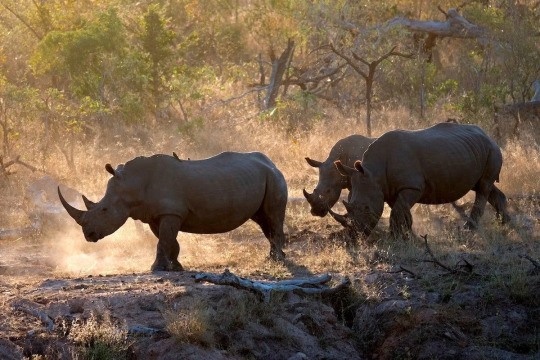
The Democratic Republic of the Congo (DRC) recently welcomed the reintroduction of 16 southern white rhinoceroses to Garamba National Park, according to officials. The last wild northern white rhino was poached there in 2006.
The white rhinos were transported to Garamba, which lies in the northeastern part of the country, from a South African private reserve. In the late 19th century, the southern white rhino subspecies was believed to be extinct due to poaching until a population of fewer than 100 was discovered in South Africa in 1895, according to WWF.
3. UK to wipe women’s historic convictions for homosexuality

Women with convictions for some same-sex activity in the United Kingdom can apply for a pardon for the first time, the Home Office has announced.
The Home Office is widening its scheme to wipe historic convictions for homosexual activity more than a decade after the government allowed applications for same-sex activity offences to be disregarded.
It means anyone can apply for a pardon if they have been convicted or cautioned for any same-sex activity offences that have been repealed or abolished.
4. Study shows human tendency to help others is universal

A new study on the human capacity for cooperation suggests that, deep down, people of diverse cultures are more similar than you might expect. The study, published in Scientific Reports, shows that from the towns of England, Italy, Poland, and Russia to the villages of rural Ecuador, Ghana, Laos, and Aboriginal Australia, at the micro scale of our daily interaction, people everywhere tend to help others when needed.
5. In a First, Wind and Solar Generated More Power Than Coal in U.S.

Wind and solar generated more electricity than coal through May, an E&E News review of federal data shows, marking the first time renewables have outpaced the former king of American power over a five-month period.
The milestone illustrates the ongoing transformation of the U.S. power sector as the nation races to install cleaner forms of energy to reduce greenhouse gas emissions from fossil fuels.
6. Iceland becomes latest country to ban conversion therapy

Lawmakers in Iceland on June 9 approved a bill that will ban so-called conversion therapy in the country.
Media reports note 53 members of the Icelandic Parliament voted for the measure, while three MPs abstained. Hanna Katrín Friðriksson, an MP who is a member of the Liberal Reform Party, introduced the bill.
7. The temple feeding 100,000 people a day

Amritsar, the north Indian city known for its Golden Temple and delicious cuisine, is also renowned for its spirit of generosity and selfless service. The city, founded by a Sikh guru, embodies the Sikh tradition of seva, performing voluntary acts of service without expecting anything in return.
This spirit of giving extends beyond the temple walls, as the Sikh community has shown immense compassion during crises, such as delivering oxygen cylinders during the COVID-19 pandemic. At the heart of Amritsar's generosity is the Golden Temple's langar, the world's largest free communal kitchen, serving 100,000 people daily without discrimination. Despite a history marred by tragic events, Amritsar continues to radiate kindness, love, and generosity.
----
That's it for this week :)
This newsletter will always be free. If you liked this post you can support me with a small kofi donation:
BUY ME A COFFEE ❤️
Also don’t forget to reblog.
1K notes
·
View notes
Text
Global rhinoceros numbers have increased to 27,000 despite populations being ravaged by poaching and habitat loss, new figures show, with some species rebounding for the first time in a decade. Rhinos numbered about 500,000 across Africa and Asia in the 20th century but their populations have been devastated. Last year, they began showing signs of recovery in some areas, although two species – the Javan and Sumatran – remain close to disappearing. Figures released by the IUCN African Rhino Specialist Group, the conservation body, indicate that the global rhino population increased to about 27,000 at the end of last year, with southern white rhino numbers increasing for the first time since 2012, from 15,942 at the end of 2021 to 16,803. In 2021, the world’s rhino population was estimated to be 26,272. Black rhinos, native to east and southern Africa, have been heavily depleted by poaching for their horns but last year increased by nearly 5%, rising from 6,195 at the end of 2021 to 6,487 at the end of 2022. This increase has happened despite a rise in black rhinos killed by poachers, and has been aided by conservationists establishing new populations that have grown in size.
Continue Reading
369 notes
·
View notes
Text

Southern white rhinoceros Ceratotherium simum simum
Observed by simben, CC BY-NC-ND
28 notes
·
View notes
Text

HOLA MOLA! Face to face with the heaviest bony fish in the world, the mola mola, or ocean sunfish, accompanied by a species infrequently found in Southern California, the pilotfish! 📸: Delaney Trowbridge Photography The largest mola on record, discovered deceased off the off the Azores Archipelago in December 2021, weighed 6,049 lb (~2,744 kg). That's equivalent to the weight of a white rhino. 🦏 🤯 And the mind-boggling facts don't end there... Molas are capable of releasing a staggering 300 million eggs in a single spawning season – a feat unparalleled among vertebrates. Unfortunately, the survival rate of tiny mola eggs is extremely low, and only a tiny fraction of the eggs will actually grow into adults.
163 notes
·
View notes
Text
There are under 16,000 white rhinos left in the wild; the northern subspecies is functionally extinct, with only two older females left in the world. So all that remain are a few thousands southern white rhinos, to include those in captivity.
The guy who owned this white rhino ranch lobbied to have the South African ban on rhino horn sales lifted, even though there are international bans still in place such as the Convention on International Trade in Endangered Species. He had cut the horns of his rhinos to keep them from being poached, and stored them away. In spite of having hundreds of millions of dollars worth of horns in his possession, he wasn't able to continue buying feed for 2,000 rhinoceroses, hence the sale.
I don't know whether that sale includes the detached horns or not. It's maddening that as we approach 2024 there are still people who will pay exorbitant fees for rhino horns as a medication even though there's zero evidence it has any effectiveness, and there are likely collectors who want one simply to have it due to their rarity. I don't know enough about the potential for legalizing trade in horns cut off of living rhinos with the aim of making poaching less lucrative to have an opinion either way, but having seen how much misrepresentation and outright lying can happen in the global trade of animal remains I'm not feeling optimistic about this as a solution.
I am, however, grateful that this massive herd of highly endangered animals--about 15% of the world population of white rhinos--are now in the hands of those who are going to get them back out into the wild, albeit in protected areas. Here's hoping that these rescued rhinos will be able to add more genetic diversity back into the wild populations and strengthen them for the future.
#rhinoceros#rhinos#ungulates#perissodactyla#mammals#wildlife#endangered species#endangered animals#extinction#nature#animals#conservation#environment#animal welfare#scicomm#charismatic megafauna#megafauna#rewilding#habitat restoration
111 notes
·
View notes